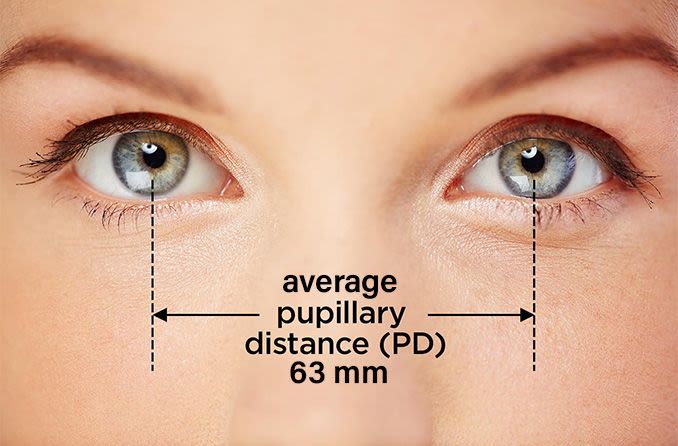What is pupillary distance and how to measure it

If you’ve ever tried on a pair of glasses and experienced (ouch!) instant eye strain, the reason could lie right between your eyes, meaning your pupillary distance could have been measured incorrectly.
Your pupillary distance (PD) — the distance between your pupils — determines comfort and how well your glasses fit.
What is pupillary distance (PD)?
Having your PD handy is just as essential as your prescription when it comes to ordering a new pair of eyeglasses or prescription sunglasses online.
The average pupillary distance for an adult is about 63 mm, but this is not a number you’ll want to guesstimate.
After all, measurement can vary widely — between 51 mm and 74.5 mm for women and 53 mm and 77 mm for men, according to military-recorded measurements.
Binocular PD or Mono PD
There are two primary methods for PD measurement: Binocular PD and mono PD.
Binocular PD is the measurement from pupil to pupil between each eye.
Mono PD is the measurement from your nose bridge to each eye.
Mono PD is believed to be the most accurate since many people may find their nose-to-pupil measurement is not equidistant on both sides.
PD is especially critical when fitting glasses with progressive lenses, which requires precise lens-to-pupil alignment to ensure comfortable vision at all distances.
How to measure pupillary distance
Your optometrist or dispensing optician typically measures PD as part of your eye exam using a pupillary distance ruler or a corneal reflex pupillometer, calibrated specifically to each eye.
Let’s say you have your eyeglass prescription and want to buy a stylish pair of wire frame glasses online. But you need your PD measurement.
No worries. You can measure your own PD in a pinch. All you need is a millimeter ruler and a mirror.
Stand about 8 inches from a mirror, holding the ruler just above your eyes and flat against your brow.
Close your right eye, and align the ruler's zero to the centre of your left eye. Without moving the ruler, close the left eye and record the measurement from your ruler's zero to the right pupil.
This distance is your PD. If you are farsighted, or are measuring for reading glasses, you’ll need to subtract 3 mm.
You may want to repeat these steps a few times to ensure you have collected the most accurate PD measurement for your new glasses.
If you are looking to purchase a second pair of glasses online but are not sure what your PD measurement is, you can easily find this from your existing glasses with the help of a felt-tip marker and your millimeter ruler.
Start with your glasses on and focus on an object about 20 feet from where you are sitting or standing.
As you are staring, reach up with the marker and make a tiny mark where the object appears in your right spectacle lens.
Repeat on the other side.
Once you’ve made both marks, these should line up into a single dot in your field of vision as you are focusing on the object. When it does, you've measured correctly.
Take off your glasses and — with your millimeter ruler — measure the distance between the two dots. Voila! You’ll have your PD measurement and can easily upgrade to a new set of frames.
Note: A do-it-yourself PD calculated with a ruler will not be as accurate as the pupillary distance measurement you would get from your optician. For the best glasses to fit your face and the distance between your eyes, schedule an eye exam.
WOULD YOU RATHER HAVE YOUR PD MEASURED BY A PRO? Find an eye doctor near you and schedule an appointment.
Page published on Wednesday, 16 March 2022






